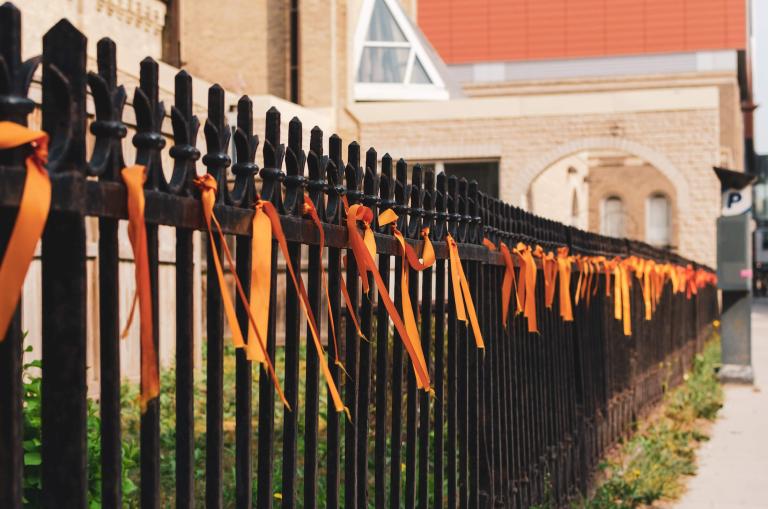National Day for Truth and Reconciliation
On this National Day for Truth and Reconciliation, we’re taking time to acknowledge and take action against the historical and ongoing mistreatment of Indigenous Peoples across Canada (Turtle Island), as well as their vibrance, diversity, and resiliency. The road to truth and reconciliation goes beyond understanding the history of Indigenous Peoples. It means building renewed relationships with Indigenous Peoples based on the recognition of their rights, respect, and partnership. At Marine Atlantic, we’re committed to continuous education and action that promotes truth, remembrance, and reconciliation with Indigenous Peoples.
In July of 2023, we proudly announced the name of our new vessel, the Ala’suinu, meaning “Traveller” in Mi’kmaq. For centuries, Mi’kmaq people have travelled between the province of Nova Scotia and the Island of Newfoundland to visit with kin and strengthen the relationships of the Mi’kmaq nation, as well as to do sustenance harvesting of natural foods. The name was chosen to both represent those who have travelled in our waters and those who will, as well as to recognize the culture and heritage of the Mi’kmaq territory in which we operate. Indigenous stakeholders in both Newfoundland and Nova Scotia were consulted regarding potential names that would recognize their culture and heritage in a respectful and meaningful manner.
Over the past month, we unveiled eight new pieces of Indigenous artwork at our three terminal buildings. Each terminal displays several pieces of Indigenous art by artists from Mi’kma’ki and Labrador. These pieces each tell a different story of Indigenous cultures and history through traditional and contemporary art forms, such as quillwork, pottery, printmaking, and painting. Indigenous art has played an important role in storytelling and preserving cultural identity and heritage for generations of Indigenous Peoples. We’re proud to support Mi’kmaq, Innu, and Inuit artists and to display their work at our terminals where our passengers and employees can learn more about local Indigenous cultures and art forms.
Learn more about the artists featured at our terminals:
Port aux Basques Terminal
Kayla Bridget Williams is a freelance artist, illustrator, designer, and mom from Cartwright, Labrador. She is a self-taught artist that has been creating ever since she could hold a pencil. Her namesake is her great grandmother Bridget Jacque/Williams from Makkovik. Kayla’s paternal family is from Nunatsiavut, and her maternal family are Scottish. Kayla enjoys painting images of her home in Labrador, animals, and other fantasy scenes from her culture and upbringing. She has had her work featured in art galleries and sells her painting and reproductions.
Learn More
Marcus Gosse (ᒪᕒᐠᑲᐢ ᐧᑲᐢ) is a Newfoundland Mi'kmaq Artist, and a member of the Qalipu Mi’kmaq First Nation Band in Newfoundland. Marcus' grandmother, Alice Maude Gosse (maiden name-Benoit), is a Mi'kmaq Elder, who was born and raised in Red Brook, NL (Weibooktoojech) located on the Port-Au-Port Peninsula. In 2005, Marcus was given his native name Papamikapow, which means "Traveler" (He who travels, not only physically, but spiritually), from an Ojibway-Cree Elder from Sandy Lake First Nation, Ontario. Marcus incorporates the ancient Mi'kmaq Star, Mi'kmaq Petroglyphs, Hieroglyphs, and various double curve designs into the landscapes of his paintings.
Learn More
Jerry Evans is Mi’kmaw and settler ancestry born in central Newfoundland. In 1986 he graduated from the Nova Scotia College of Art and Design with a Bachelor of Fine Art. He completed an Education Degree at Memorial University of Newfoundland and Labrador and has been a practicing Visual Artist for over thirty years. Primarily a painter and printmaker, Jerry is also a multi-media artist who has worked in film, has qualified and reclaimed traditional hand poke tattoo as a means of expression and gift exchange, and has created regalia for annual Mawiomi and pow wow dancing for more than a 2 decades. Jerry coordinated and was principal researcher for the 1996 exhibition FIRST: Aboriginal Artists of Newfoundland and Labrador, which presented works by aboriginal artists in Newfoundland and Labrador to provincial audiences, and for many years worked as shop technician and master printer at St. Michael’s Printshop in St. John’s where he has helped artists like Anne Meredith Barry, Michael Robinson and Joseph Norman render their work as lithographs. His own visual artwork has been exhibited across Canada, and internationally and is included in private and public collections across the country. He has been an Artist-in-Residence in Canada and Ireland, has received grants from the Canada Council and the Newfoundland and Labrador Arts Council, and is working to develop and deepen his collaborative creative practice and work with communities.
North Sydney Terminal
Loretta Gould is a Mi'kmaw artist from the Waycobah First Nation in Cape Breton. Her art is Spiritual, and it's said it's a dream to see bright, beautiful colors. Her first paintings sold in Finland and Germany. She has spent her whole life creating with fabric, photos, and acrylics. She is a self-taught artist and has been creating and exhibiting her work ever since. Loretta's dream is to share her art around the world. It is a way to get her Spiritual feelings on canvas. She was born and raised in Cape Breton, raised in a reservation by her parents.
Melissa Peter-Paul is a Mi'kmaw woman from Abegweit First Nation, located on Epekwitk (PEI). Growing up, Melissa was immersed in cultural teachings and was surrounded by a family of basket makers. She began her artistic expression at a young age, making regalia and beadwork, and is skilled in both traditional and contemporary styles. Melissa's exposure to other Mi'kmag artforms led her to quillwork, a traditional skill in which the ancestors of her maternal grandfather excelled. Melissa was accepted into an apprenticeship with Mi'kmag Quill Art in 2015. Her training was grounded in the traditional insertion technique and utilized the study of both cultural teachings and formal material culture resources available through historic publications and museums. Quillwork is created by inserting porcupine quills, either dyed or kept natural, into birchbark. The pieces are then edged with quills, sweetgrass or spruce root. Over the course of her apprenticeship, Melissa learned techniques and protocols related to harvesting raw materials, as well as the complex geometry of traditional design work. Upon completion of her apprenticeship, Melissa has been integral in establishing a community of skilled quill workers. This community of quillers seeks to expand awareness of the artform and recently began working on collaborative projects. Melissa launched her professional career as a Mi'kmaq quill artist with her first solo exhibit at Receiver Coffee presented by This Town is Small in Charlottetown in 2019. She is heavily influenced by 20th century Mi kmaq quillwork, and she is supported in her harvesting efforts by her family. Melissa is proud to be passing the art on to her two sons and the broader community.
Jordan Bennett's ongoing practice utilizes painting, sculpture, video, installation, and sound to explore land, language, the act of visiting, familial histories and challenging colonial perceptions of Indigenous histories, stereotypes, and presence with a focus on exploring Mi'kmaq and Beothuk visual culture of Ktaqmkuk. In the past 15 years, Jordan has participated in over 100 group and solo exhibitions nationally and internationally. Most notably he has been long listed for the 2015 and 2016 Sobey Art Award, was shortlisted for the 2018 Awards and was a long list winner in 2020. The artist has completed large-scale public art commissions including Zatzman Sportsplex (Dartmouth, NS), OCAD University (Toronto, ON), and Beaverbrook Art Gallery (Fredericton, NB). His 100-foot installation "Tepkik," highlighted in the National Art Gallery of Canada for the 2019 exhibition "Àbadakone," was the 2020 winner of the Lieutenant Governor of Nova Scotia Masterworks Arts Award.
Argentia Terminal
Agathe Aster is a proud Innu woman who speaks Innu-aimun and has lived her whole life in Sheshatshiu. A mother of four, Agathe is a self-taught artist who has been drawing since she was a child. Agathe has been mentored by other artists in Sheshatshiu, including her grandmother, who she says has always guided her. Her work reflects her passion for her culture, her land, and Innu traditions. The Innu have been on the land for over 6,000 years and some of the designs included in Agathe’s works are based on this long Innu history.
Learn More
Nancy E. Oakley is a Mi’kmaw/Wampanoag artist. She was raised in Mashpee, Massachusetts, and is now living and working on the Eskasoni First Nation reserve in Cape Breton, Nova Scotia. She is a graduate of the Institute of American Indian Arts in Santa Fe, New Mexico, where she studied photography and pottery. After graduating, she moved to Nova Scotia and studied for a year at the Nova Scotia School of Art and Design, taking courses in photography, ceramics, weaving, and jewelry making, before leaving to start her family. She is now a mother of 6 and grandmother of 4.Through softly curved pottery forms created by hand and on the wheel, Nancy creates culturally significant pieces that imbue her spiritual and traditional knowledge and honour her role as a mother. Her process is a collaboration with the land. Clay harvested from mother earth and shaped by hand. Pieces are stone polished, and smoke fired outdoors with fir tips, seaweed, and sawdust, imprinting beautiful smokey finishes. Her pots are then adorned with traditional Mi’kmaq embellishments such as black ash basketry, beadwork, carved and or painted hieroglyphics and braided sweetgrass.
Marine Atlantic would like to respectfully acknowledge that we operate in Mi'kma'ki, the ancestral and unceded territory of the Mi kmaq Peoples, and on the island of Ktaqmkuk, the unceded, traditional territory of the Beothuk and the Mi'kmaq Peoples. We also acknowledge Labrador as the traditional and ancestral homelands of the Innu of Nitassianan, the Inuit of Nunatsiavut, and the Inuit of NunatuKavut.




